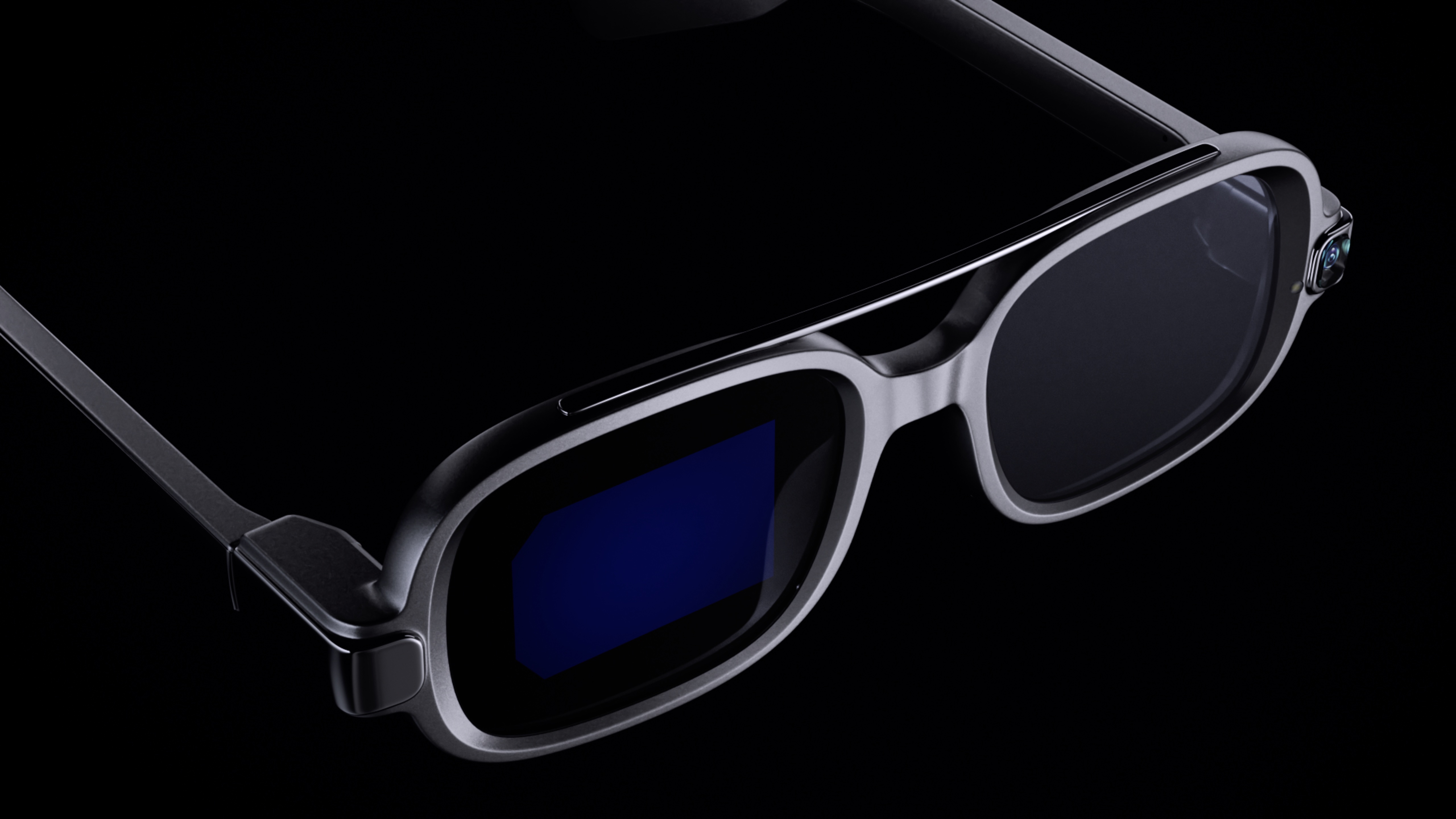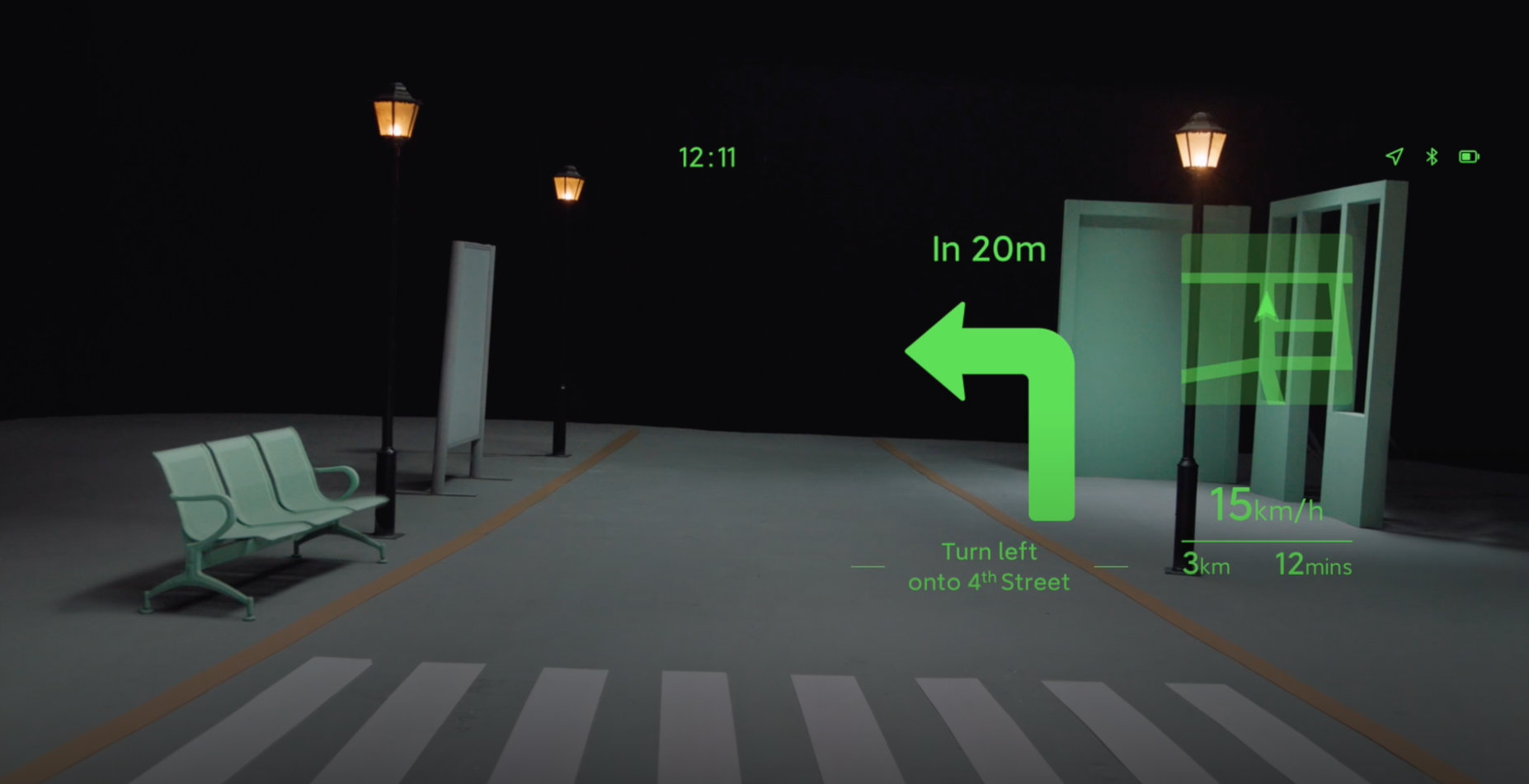 Xiaomi's Smart Glasses. That's a camera on the right of the picture and the display system on the left. That blue area in the lens is the waveguide display.
Xiaomi's Smart Glasses. That's a camera on the right of the picture and the display system on the left. That blue area in the lens is the waveguide display. Explode! You can start to see the display system on the left.Xiaomi
Explode! You can start to see the display system on the left.Xiaomi A microLED display fires into a series of lenses and then rounds the corner into the lens.Xiaomi
A microLED display fires into a series of lenses and then rounds the corner into the lens.Xiaomi The lens is a waveguide which magnifies the microLED light and directs it into your eye. The lens looks fairly thick and actually goes into the glasses arm.Xiaomi
The lens is a waveguide which magnifies the microLED light and directs it into your eye. The lens looks fairly thick and actually goes into the glasses arm.Xiaomi The microLED component. This sure does look like a real, working device.Xiaomi
The microLED component. This sure does look like a real, working device.Xiaomi The display is very tiny.Xiaomi
The display is very tiny.Xiaomi Either Xiaomi is really detailed at special effects or this is a working prototype. Here it's showing a clock.Xiaomi
Either Xiaomi is really detailed at special effects or this is a working prototype. Here it's showing a clock.Xiaomi The back. I'm guessing those big bumps around the ear are for the batteries.Xiaomi
The back. I'm guessing those big bumps around the ear are for the batteries.Xiaomi A closeup of the camera.Xiaomi
A closeup of the camera.Xiaomi On the left, I spy a set of buttons on the arm, and there's a microphone hole by the nose pad.Xiaomi
On the left, I spy a set of buttons on the arm, and there's a microphone hole by the nose pad.Xiaomi
Xiaomi—the world's biggest smartphone manufacturer—would like to briefly divert your tech attention away from the iPhone 13 launch to a new pair of AR goggles called "Xiaomi Smart Glasses." The company calls this a "concept" device, but previous Xiaomi "concept" devices have turned into real, for-sale products. There's no release date or price point yet, but it looks like it's a working device. Xiaomi's feet are firmly on the ground, and there isn't much about the product that hasn't been done before by Google Glass or Snapchat Spectacles.
The Smart Glasses look like a slightly bulky pair of prescription eyeglasses, with a 5MP camera in one corner and the display system in the other. The display system is wild—a microLED display fires into a series of lenses and then into a waveguide lens for the right eye only. Cramming a microLED into a pair of glasses apparently wasn't easy—Xiaomi says the chip measures 2.4 mm x 2.02 mm, with individual pixels sized at 4 μm. The big compromise is that the microLED system is actually monochrome: the glasses can only display green, so you'll feel right at home if you ever used a computer in the 1980s.
The biggest AR glasses product on the market is Snapchat Spectacles, and those take a more advanced approach to vision, with two full-color waveguide lenses. Xiaomi is pushing the envelope with microLED, while Snapchat appears to be using tiny DLP projectors that project into the waveguides. Snapchat was so impressed with its display supplier that it decided to buy the company—called "WaveOptics"—in March for $500 million.
The Xiaomi Smart Glasses do not appear to focus much on 3D object capabilities—with only one display lens, the glasses can't display 3D anyway. By contrast, Snapchat Spectacles are a real augmented reality platform with two lenses, stereoscopic vision, and 3D placement of virtual objects into the real world based on the wearer's perspective. Most of Xiaomi's demoed interfaces worked more like Google Glass—a 2D, smartwatch-style interface that transparently hangs out in your field of vision. The one exception was the translation mode, which—just like Word Lens—can place translated text over top of foreign text in the real world.
 The display in (simulated) action. Did we mention it's monochrome? It's so green.
The display in (simulated) action. Did we mention it's monochrome? It's so green. A big problem with AR goggles is that nobody makes AR goggle software, so here is the very sad list of apps. (You can also start to pick up on the headset's Android OS roots here.)Xiaomi
A big problem with AR goggles is that nobody makes AR goggle software, so here is the very sad list of apps. (You can also start to pick up on the headset's Android OS roots here.)Xiaomi Xiaomi is either good at special effects or this is a working prototype, but anyway here's a clock.Xiaomi
Xiaomi is either good at special effects or this is a working prototype, but anyway here's a clock.Xiaomi A phone call.Xiaomi
A phone call.Xiaomi A message.Xiaomi
A message.Xiaomi It can do Word Lens-style translation.Xiaomi
It can do Word Lens-style translation.Xiaomi
Software is what makes a device useful, and a big problem with AR glasses is that no AR operating system, app store, or app ecosystem exists. Xiaomi showed a whopping five functions in the video: notifications, phone calls, maps, picture-taking, and translation. There was no app store or developer API to speak of. Xiaomi is using a heavily customized version of Android for the OS and the "XiaoAI AI Assistant" for voice command. These are the primary ways of interacting with the glasses.
Like a smartwatch, there are both onboard processing capabilities that allow the glasses to "independently complete functions such as navigation, taking photos, teleprompter, and real-time text and photo translations" and smartphone pairing, for mirroring notifications and making calls.
Under the hood, the glasses use a quad-core ARM processor. There's a touchpad on the side, along with three buttons along the bottom edge of the right arm. What looks like a microphone is cleverly hidden in the nose pad.
Again, it's hard to tell how much of this is real or if Xiaomi wants to sell a new device. But no pie-in-the-sky concepts are being pushed here. The glasses are actually disappointingly realistic and limited, which makes us think they really exist somewhere in Xiaomi's labs.
Listing image by Xiaomi
"smart" - Google News
September 15, 2021 at 05:38AM
https://ift.tt/3AchsaD
Xiaomi shows off smart glasses with an all-green, microLED, waveguide display - Ars Technica
"smart" - Google News
https://ift.tt/2P2kUhG
https://ift.tt/3febf3M
Bagikan Berita Ini














0 Response to "Xiaomi shows off smart glasses with an all-green, microLED, waveguide display - Ars Technica"
Post a Comment